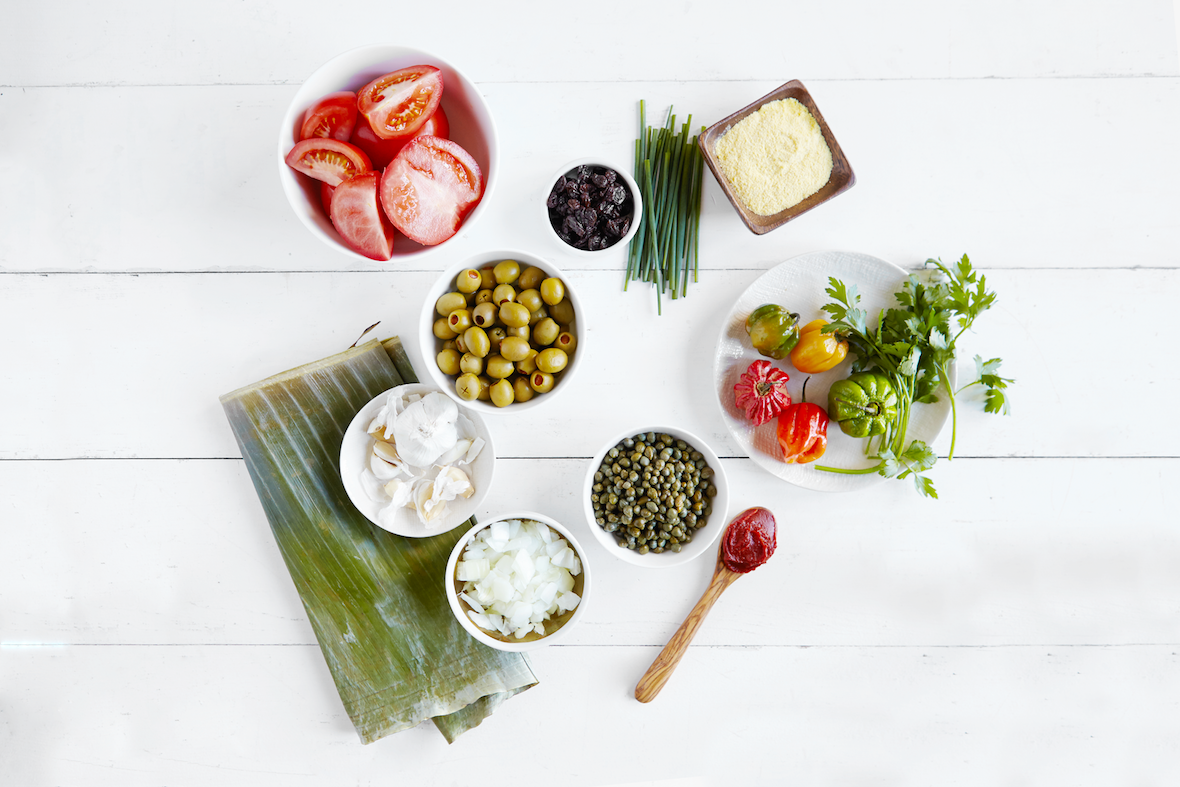https://www.instagram.com/p/BM6yj5UBQV3/
For those hailing from Trinidad and Tobago, nothing recalls the flavor of home so much as pastelles. These pillowy pockets of cornmeal-encased ground meat are engrained in cultures throughout the Caribbean and Latin America, though both recipes and names for the dish differ nation-to-nation. In Trinidad and Tobago, pastelles are traditionally made around Christmas time, when families, friends and neighbors—mostly ladies—gather together for an epic pastelle-making party.
The end result of two days of chopping, mixing, folding, tying and steaming is typically around 200 pastelles, which are divvied up between the chefs. People without a direct hand in the process aren’t left out of the eating action, though; they either buy or barter their way in for a share of the goods—a transaction commonly called “putting in your order.”
“Putting in your order,” however, isn’t as straight forward in New York City. Though Brooklyn is home to the largest population of Trinidadians and Tobagonians outside of the island country, located just north of Venezuela, scant options exist here for many looking to get their pastelle fix. A nostalgic expat could make pastelles themselves, but time and ingredients are often in short supply. Alternatively, they may be able to place an order with a local family that makes pastelles on the DL, but that requires knowing someone. As a result, many wind up going without; others unsatisfactorily satiate their cravings with other countries’ take on pastelles, such as Mexico’s corn husk-wrapped tamales or Puerto Rico’s yucca and plantain-heavy pasteles.
Finally, though, a T&T pastelle lifeline has opened. Michelle Nurse-St Luce, a native Trinidadian turned U.S. citizen, has stepped up to the pastelle-making plate to fill what she perceives as a culinary void not only in her own community but all of Brooklyn. Trini Pastelles, the gastronomic popup she recently founded, has begun bringing her mother’s pastelle recipe to the masses, first at the Queens Night Market, then the African Food Festival and now every Saturday at Sycamore Flower Shop & Bar in Ditmas Park. Nurse-St Luce is clearly onto something: she serves up to 150 pastelles per night, and younger customers have begun bringing their moms and aunties back to the bar for more, or buying a dozen pastelles to take home. “Trinidadians have been very encouraging, young and old,” Nurse-St Luce says. “But it’s not just them—everyone is open to trying it, from hipsters to LGBT folks and Caribbean customers. That’s why I love Brooklyn.”
She has found, however, that even in cultured Brooklyn there’s a slight learning curve to overcome: many non-Trinidadian and Tobagonian customers mistakenly assume she’s serving tamales. “In the beginning I was like, ‘Woah, no! This is totally different,’” she says. “But now I understand the confusion, and I’m happy to explain it to them.” That goes for patrons from other Latin countries as well. Oftentimes, they are surprised—and delighted—to discover Trinidad and Tobago has their own distinct version of the beloved dish.

Nurse-St Luce moved to the U.S. with her mom, a nurse, after high school to attend St. Francis College on a scholarship. She quickly settled in, meeting her now-husband her senior year. Though she has no plans to ever leave Brooklyn, she still refers to eastern Trinidad as home, and considers pastelles a significant part of her heritage. She’s helped make them since literally before she can remember. “I’m told that when I was two years old, they’d sit me down and say, ‘Michelle, just wipe the banana leaf,’” she says. “I’ve always had pastelles in me.”
In Trinidad and Tobago, everyone is assigned a role in the pastelle-making process (though men usually “scurry away” when the time comes, Nurse-St Luce says, chuckling). Young boys are often sent outside to cut banana leaves, used for wrapping the pastelles and holding their shape. Girls may wipe the leaves and singe them over a fire, or mix and heat the cornflower. Teens handle the meats, working in olives, tomatoes, raisins and various seasonings. “When I was younger I was banana leaf girl, then cornflower girl, then boiling cornflower girl and then meat girl,” Nurse-St Luce recalls.
Master pastelle makers—usually the adult women in the group—wed meat with cornmeal, filling a ball of dough with a couple spoonfuls of filling and then smashing the mixture together with a traditional wooden pastelle press, a bespoke instrument that is oftentimes passed down through families. Finally, the pastelle is wrapped up, Christmas present like, in a banana leaf, and tied together with a string (that latter duty is often considered the most tedious part of the job, and, in some families, a dreaded punishment for a naughty child). After a quick dunk in the steamer, the moist morsels are cooled and ready to go, served fresh on Christmas morning or else popped into the freezer to enjoy for the rest of the year. “They last a long time,” Nurse-St Luce says. “People will be cleaning out their freezer and get excited to find a pastelle from last year.”

Nurse-St Luce didn’t set out to found a food startup. In college she double-majored in psychology and business management, and then did a master’s in London in human resources management; she currently works full time in administration. Her mission to deliver pastelles to the masses only struck in 2012, when she visited Smorgasburg with her four-month-old son. “I loved it the idea of all these food startups making specific things that they were really good at,” she says. “I really wanted to be a part of it.”
It took several years of experimenting with recipes and building up her courage before she founded Trini Pastelles in late 2015. She originally hoped to partner with her mother, but chronic arthritis dashed that plan, so she went at it alone. She managed to land a spot at Brooklyn FoodWorks, a culinary incubator located in an unassuming building in South Williamsburg. There, she made connections with other small local companies, including Happy Valley Meat. “The Happy Valley guys were like, ‘Michelle! Try this lamb,’” she says. “I was blown away—it’s really good!” Though lamb is not a traditional pastelle filling, it’s now Nurse-St Luce’s best-selling flavor.
In addition to her melt-in-your-mouth lamb pastelles, there’s chicken, pork, fish and beef. And following the advice of a friend, she recently developed a vegetarian version, made with lentils, soy and sweet potato. “For first timers, I usually recommend the beef or chicken because they’re the most traditional,” she says. “But I love experimenting with random, quirky stuff; I’m considering an alligator pastelle, for example.”
The pastelles are predominantly made with organic, fresh local ingredients, and Nurse-St Luce also stepped up the accompanying ‘chow-chow’ spicy sauce—a quintessential pastelle condiment. In Trinidad and Tobago most people use a bottled go-to called Matouk’s Hot Chow, but she desired something fresher and with greater quality control. Her tangy mustard-based, sweet pickle and scotch bonnet-laced concoction is so popular that she plans to begin bottling it.
Eventually, Nurse-St Luce would like to go full time with Trini Pastelles, with an ultimate dream of opening a pastelle-centric bar in Brooklyn (“Patelles go really well with beer, especially ginger beer,” she points out), though for now pastelles remain a nights-and-weekends gig. Hungry patrons can find her at Sycamore from 6:00 p.m. to midnight each Saturday, or can arrange catering and frozen orders online. “I enjoy doing this, I really do,” she says. “It keeps me in the Trini mindset.”



